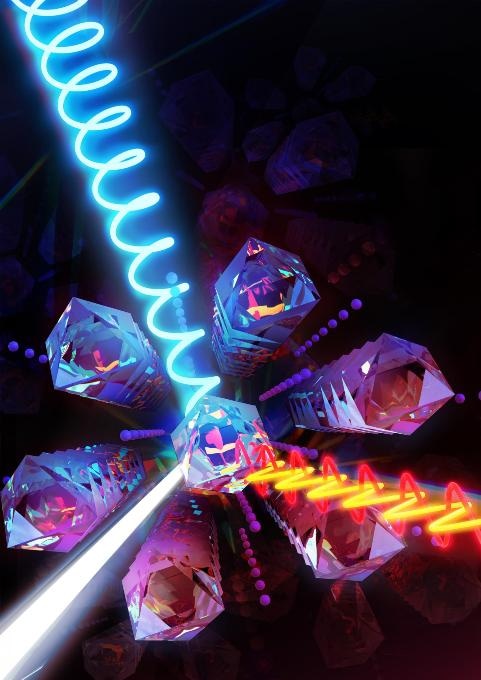Jun 21 2018
One of the key challenges for autonomous vehicles is to guarantee that they can detect and sense objects - even in dense fog. Compared to the existing visible light-based cameras, infrared cameras can offer much better visibility through the smoke, fog, or minute particles that can scatter the visible light.
 Artist's rendering of light interacting with BaTiS3 crystals. (image credit: Talia Spencer)
Artist's rendering of light interacting with BaTiS3 crystals. (image credit: Talia Spencer)
Within the air, infrared light, which falls within a specific range referred to as mid-wave infrared, scatter a lot less compared to other visible or other infrared light waves. Furthermore, infrared cameras can see more effectively in the dark, when no visible light is present. However, presently the utilization of infrared cameras is restricted by their heavy cost and lack of effective materials. This is where materials, which contain exceptional optical properties in the infrared and can be scalable, might make a difference in providing optimized object identification in numerous technologies including autonomous vehicles.
A new material created by researchers at the USC Viterbi School of Engineering and the University of Wisconsin together with researchers from Air Force Research Laboratories, University of Missouri, and J.A. Woollam Co. Inc, might have potential for such infrared detection applications as emergency services, autonomous vehicles, and even manufacturing.
The research team of Jayakanth Ravichandran, an assistant professor of materials sciences at the USC Viterbi School of Engineering has been analyzing a new group of materials known as chalcogenide perovskites. One of these materials is barium titanium sulfide (BTS), a material rediscovered and created in large crystal form by Shanyuan Niu, a doctoral candidate in the Materials Science program at the USC Mork Family Department of Chemical Engineering and Materials Science.
Ravichandran's research group partnered with the research groups of Mikhail Kats, an assistant professor of electrical and computer engineering at the University of Wisconsin-Madison and Han Wang, an assistant professor of electrical engineering and electrophysics in USC's Ming Hsieh Department of Electrical Engineering to explore the way infrared light interacts with this material. These scientists learned that this material interacted in a diverse way with light in two different directions.
"This is a significant breakthrough, which can affect many infrared applications," says Ravichandran.
This direction-dependent interaction with light is characterized by an optical property referred to as birefringence. In basic terms, birefringence can be seen as light moving at various speeds in two directions in a material. Similar to sunglasses with polarized lenses block glare, BTS has the ability to slow down or block light based on the direction in which it travels in the material. The scientists are affirmative that their material, barium titanium sulfide, has the maximum birefringence among identified crystals.
"The birefringence is larger than that of any known solid material, and it has low losses across the important long-wave infrared spectrum," says Kats.
How BTS could improve infrared vision:
The BTS material can be used to develop a sensor to filter out some polarizations of light to realize better contrast of the image. It could also assist in filtering light coming from various directions to enable detection of a remote object's characteristics. This could be especially vital for enhancing infrared vision used in autonomous vehicles, which need to see the whole landscape around them even in low visibility circumstances.
"The hope is that in the future, a BTS-enhanced sensor in a car would function as retinas do to the human body," says Niu.
The authors are certain these infrared-responsive materials can widen human perception. Apart from autonomous vehicles, there are other probable temperature measurement or heat sensing applications. One application could be in the development of imaging tools used by firefighters to produce an immediate temperature map outside a burning building to judge where a fire is spreading and where emergency responders need to rescue trapped persons.
Currently, the cost of infrared equipment makes it too costly for all fire stations to own such equipment. BTS, which is composed of elements that are plentiful in earth crust—could make infrared equipment economical and effective. Furthermore, such materials are safer for both the user and the environment, as well as easier to dispose of than the materials that are used presently, which contain dangerous elements such as cadmium and mercury.
These materials could also be beneficial in devices that sense risky gases, molecules, even biological systems. The applications span from pollution monitoring, heat sensing, to medicine.
"To date, the constraint of existing mid-IR materials is a big bottleneck to translate many of these technologies," says USC's Wang.
The scientists hope that a detailed study in this area will make a number of these technologies a reality in the days to come.
The study on BTS is described in "Giant optical anisotropy in a quasi-1D crystal" reported in Nature Photonics.